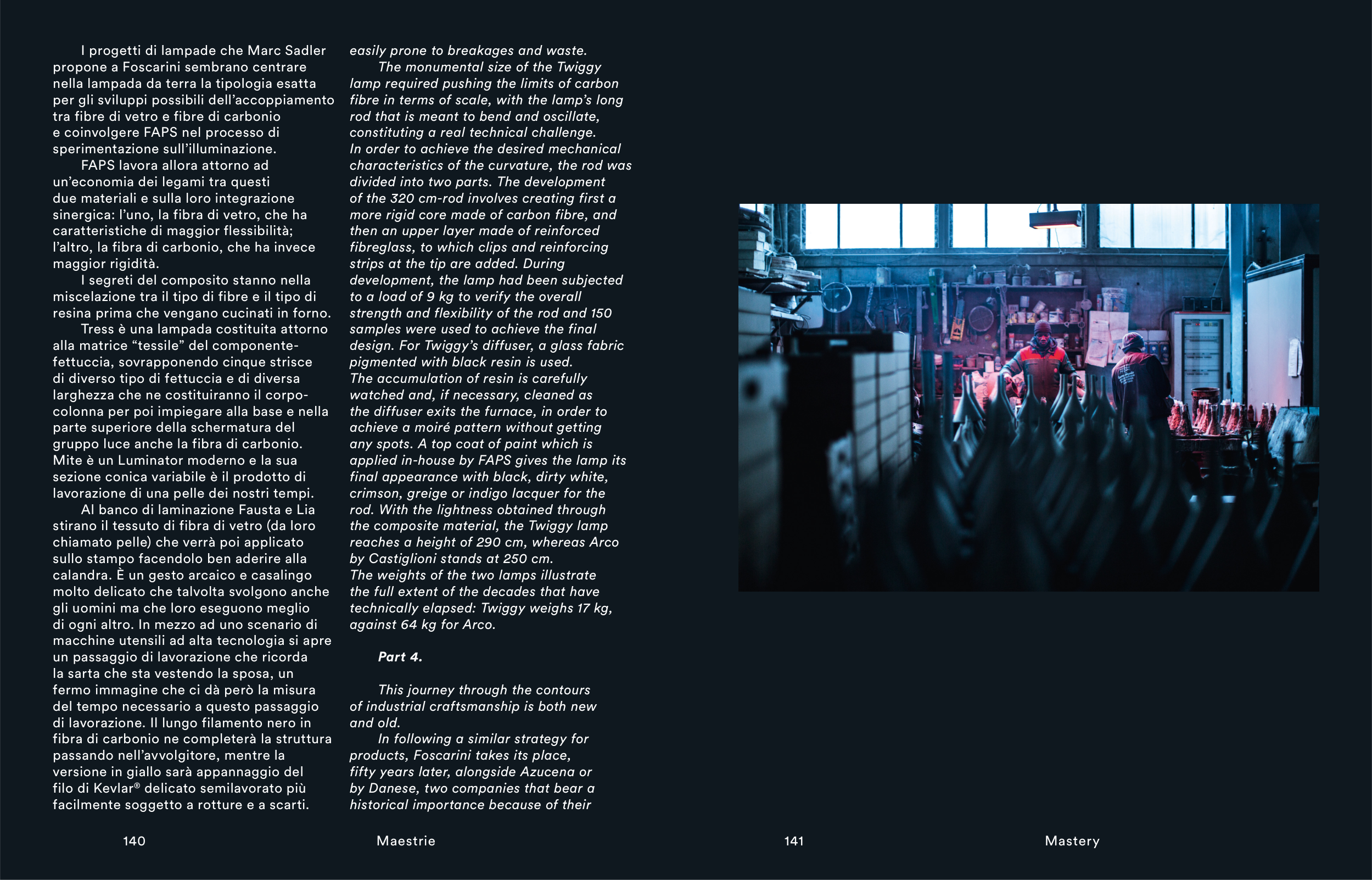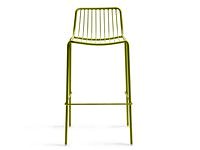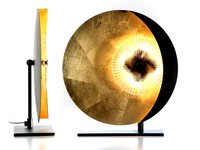141
Mastery
I progetti di lampade che Marc Sadler
propone a Foscarini sembrano centrare
nella lampada da terra la tipologia esatta
per gli sviluppi possibili dell’accoppiamento
tra fibre di vetro e fibre di carbonio
e coinvolgere FAPS nel processo di
sperimentazione sull’illuminazione.
FAPS lavora allora attorno ad
un’economia dei legami tra questi
due materiali e sulla loro integrazione
sinergica: l’uno, la fibra di vetro, che ha
caratteristiche di maggior flessibilità;
l’altro, la fibra di carbonio, che ha invece
maggior rigidità.
I segreti del composito stanno nella
miscelazione tra il tipo di fibre e il tipo di
resina prima che vengano cucinati in forno.
Tress è una lampada costituita attorno
alla matrice “tessile” del componente-
fettuccia, sovrapponendo cinque strisce
di diverso tipo di fettuccia e di diversa
larghezza che ne costituiranno il corpo-
colonna per poi impiegare alla base e nella
parte superiore della schermatura del
gruppo luce anche la fibra di carbonio.
Mite è un Luminator moderno e la sua
sezione conica variabile è il prodotto di
lavorazione di una pelle dei nostri tempi.
Al banco di laminazione Fausta e Lia
stirano il tessuto di fibra di vetro (da loro
chiamato pelle) che verrà poi applicato
sullo stampo facendolo ben aderire alla
calandra. È un gesto arcaico e casalingo
molto delicato che talvolta svolgono anche
gli uomini ma che loro eseguono meglio
di ogni altro. In mezzo ad uno scenario di
macchine utensili ad alta tecnologia si apre
un passaggio di lavorazione che ricorda
la sarta che sta vestendo la sposa, un
fermo immagine che ci dà però la misura
del tempo necessario a questo passaggio
di lavorazione. Il lungo filamento nero in
fibra di carbonio ne completerà la struttura
passando nell’avvolgitore, mentre la
versione in giallo sarà appannaggio del
filo di Kevlar® delicato semilavorato più
facilmente soggetto a rotture e a scarti.
easily prone to breakages and waste.
The monumental size of the Twiggy
lamp required pushing the limits of carbon
fibre in terms of scale, with the lamp’s long
rod that is meant to bend and oscillate,
constituting a real technical challenge.
In order to achieve the desired mechanical
characteristics of the curvature, the rod was
divided into two parts. The development
of the 320 cm-rod involves creating first a
more rigid core made of carbon fibre, and
then an upper layer made of reinforced
fibreglass, to which clips and reinforcing
strips at the tip are added. During
development, the lamp had been subjected
to a load of 9 kg to verify the overall
strength and flexibility of the rod and 150
samples were used to achieve the final
design. For Twiggy’s diffuser, a glass fabric
pigmented with black resin is used.
The accumulation of resin is carefully
watched and, if necessary, cleaned as
the diffuser exits the furnace, in order to
achieve a moiré pattern without getting
any spots. A top coat of paint which is
applied in-house by FAPS gives the lamp its
final appearance with black, dirty white,
crimson, greige or indigo lacquer for the
rod. With the lightness obtained through
the composite material, the Twiggy lamp
reaches a height of 290 cm, whereas Arco
by Castiglioni stands at 250 cm.
The weights of the two lamps illustrate
the full extent of the decades that have
technically elapsed: Twiggy weighs 17 kg,
against 64 kg for Arco.
Part 4.
This journey through the contours
of industrial craftsmanship is both new
and old.
In following a similar strategy for
products, Foscarini takes its place,
fifty years later, alongside Azucena or
by Danese, two companies that bear a
historical importance because of their
140
Maestrie





